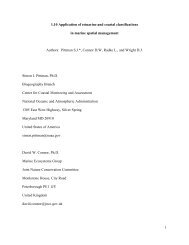Seamounts, Ridges, and Reef Habitats of American Samoa
Seamounts, Ridges, and Reef Habitats of American Samoa
Seamounts, Ridges, and Reef Habitats of American Samoa
- No tags were found...
You also want an ePaper? Increase the reach of your titles
YUMPU automatically turns print PDFs into web optimized ePapers that Google loves.
794Seafloor Geomorphology as Benthic <strong>Habitats</strong>0015Regional Scale Geomorphic Featuresp0055p0060p0065p0070<strong>Seamounts</strong>: Previous studies <strong>of</strong> the <strong>Samoa</strong>n isl<strong>and</strong>s have reported regional bathymetryas predicted from satellite altimetry [1]. Multibeam bathymetry surveys have beenrestricted to local areas covered by one or two cruises [19,20] that primarily supportedstudies <strong>of</strong> the geochemical signature <strong>and</strong> age progression <strong>of</strong> western portion <strong>of</strong>the <strong>Samoa</strong>n volcanic province 1,20–22. This case study introduces the first regionalscale, multicruise, multibeam bathymetry <strong>of</strong> the eastern portion <strong>of</strong> the <strong>Samoa</strong>n lineament,providing an overview <strong>of</strong> the bathymetric setting west <strong>of</strong> Savai’i <strong>and</strong> Upolu,<strong>and</strong> clearer implications <strong>of</strong> the seamount trails <strong>and</strong> other volcanic knolls revealedtherein. Although we are using the IHO [23] definition <strong>of</strong> seamount in this book, itis useful to note that definitions <strong>of</strong> what constitute a “seamount” do vary, especiallyin light <strong>of</strong> a growing multidisciplinary seamount biogeosciences community whereknolls are included in the definition (as discussed in more detail in Ref. [24]).Figure 58.1 shows a new bathymetric compilation <strong>of</strong> <strong>American</strong> <strong>Samoa</strong> based onmultibeam sonar data available from 14 cruises from 1984 through 2006, coveringan area <strong>of</strong> 28,446 km 2 . The map also shows the locations <strong>of</strong> 51 previously undocumentedseamounts <strong>and</strong> volcanic knolls. Figure 58.2 summarizes the geomorphicinterpretation for the region by delineating major rift zones, subaerial <strong>and</strong> submarineeruptive centers, volcanic plateaus, <strong>and</strong> the outlines <strong>of</strong> the most prominentseamounts <strong>and</strong> volcanic knolls. Particularly <strong>of</strong> note are the many small seamountsprevalent throughout ESVP from Ofu-Olosega westward, especially on the northernflank <strong>of</strong> South Bank <strong>and</strong> stretching from Ofu-Olosega across the inter-rift valley tothe 2% Bank-Southeast Bank (aka Tulaga-Malumalu) saddle.In the current global census <strong>of</strong> seamounts, only 200 have been sampled, <strong>and</strong> in nosystematic fashion [7], but future studies based on this current study hold promise forexploring a possible relationship between seamount shape <strong>and</strong> habitat. Topographic/bathymetric position index (TPI/BPI) is important in a vertical sense (e.g., speciesrichness along a vertical biodiversity gradient, as discussed in Refs. [25–27]). Furtherstudies (beyond the scope <strong>of</strong> this case study) will test the hypothesis if seamount size<strong>and</strong> shape (in a more horizontal cross-sectional sense) bear any relationship to speciesdiversity <strong>and</strong> richness, especially with geomorphic <strong>and</strong> hydrodynamic processesinfluencing marine ecological communities on a range <strong>of</strong> scales [28,29]. Below wefocus on some <strong>of</strong> the largest seamounts, but the reader is referred to Roberts [30] formore extensive description <strong>and</strong> geomorphic analysis <strong>of</strong> undersea volcanic featuresthroughout the entirety <strong>of</strong> the ESVP, as well as shape <strong>and</strong> distribution analyses <strong>of</strong>seamounts <strong>and</strong> a discussion <strong>of</strong> the age progressions <strong>of</strong> volcanic lineaments.Tutuila: The large seamounts, guyots, knolls, <strong>and</strong> breaching isl<strong>and</strong>s <strong>of</strong> the ESVPdemonstrate complex eruptive patterns. Perhaps the most intricate is the Tutuila complex,composed <strong>of</strong> five separate volcanic centers ([15]; Figure 58.2) <strong>and</strong> representingthe largest structure in the ESVP, with a volume <strong>of</strong> 4,957 km 3 (as calculated usingsources from Ref. [4]. Tutuila is unique with its highly elongate primary rift zonethat trends 70° [15], as opposed to the rest <strong>of</strong> the <strong>Samoa</strong>n chain trending at 110°.Indeed, en echelon lineaments both to its east <strong>and</strong> west delineate that primary riftzone trend (110°), with the isl<strong>and</strong> itself marking an interruption in that dominant rift
















